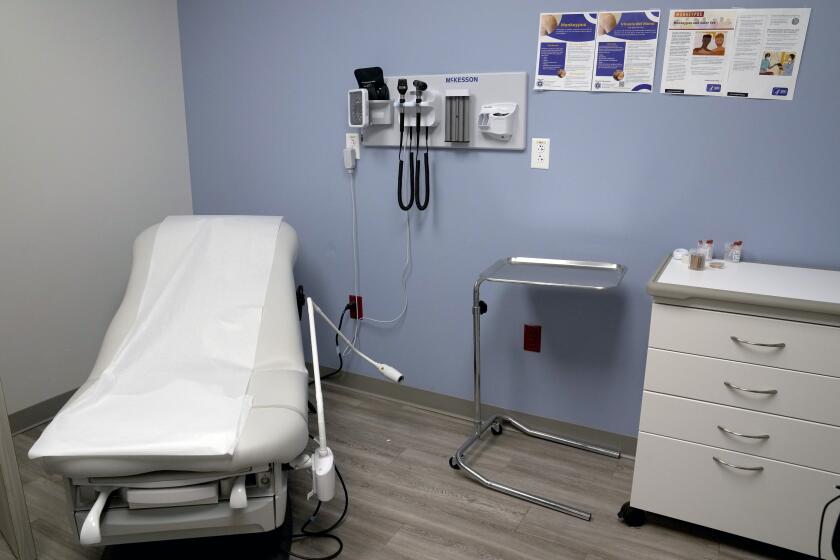Column: California confronts the complexities of creating a single-payer healthcare system

California Assembly Speaker Anthony Rendon may have expected to torpedo the idea of a statewide single-payer healthcare system for the long term last June, when he blocked a Senate bill on the issue from even receiving a hearing in his house.
He was wrong, of course. His shelving of the Senate bill created a political uproar (including the threat of a recall effort), forcing him to create a special committee to examine the possibility of achieving universal health coverage in the state. On Monday and Wednesday, the Select Committee on Health Care Delivery Systems and Universal Coverage held its final hearings.
The panel ended up where it started, with the recognition that the project is hellishly complex and politically daunting but still worthwhile — yet can’t happen overnight. “I’m anxious to see what it is that we can actually be working on this year,” committee Co-Chair Jim Wood (D-Healdsburg) said toward the end of Wednesday’s seven-hour session. “Some of the logistics and the challenges we have to deal with are multiyear challenges.”
The No. 1 experience missing from the American healthcare system is peace of mind.
— Michael Lighty, California Nurses Assn.
Little has changed since last year, when a measure sponsored by the California Nurses Assn., SB 562, passed the Senate in June and was killed by Rendon (D-Paramount) in the Assembly. The same bill, aimed at universal coverage for all residents of the state, including undocumented immigrants, is the subject of the select committee’s hearings and the template for statewide reform.
Backers of the Healthy California program envisioned by the bill feel as if they’re in a race with federal officials intent on dismantling healthcare reforms attained with the Affordable Care Act, and even those dating from the 1960s with enactment of Medicare and Medicaid.
In just the last few weeks, the U.S. Department of Health and Human Services has approved adding a work requirement to Medicaid in Kentucky and begun considering a plan to place lifetime limits on Medicaid benefits — profound changes in a program traditionally aimed at bringing healthcare to needy families.
The Republican-controlled Congress effectively repealed the individual mandate in the Affordable Care Act. That is likely to drive up premiums for unsubsidized middle-income insurance buyers and has prompted California and other states to consider implementing such a mandate on their own. (Idaho is moving distinctly in the opposite direction from California, proposing to allow “state-based health plans” that allow insurers to discriminate against applicants with pre-existing conditions.
Healthy California would be the most far-reaching single-state project for universal health coverage in the nation. That’s to be expected, since the state’s nation-leading population (39 million) and gross domestic product ($2.6 trillion) provide the impetus to solve big social and economic issues on its own.
The program would take over responsibility for almost all medical spending in the state, including federal programs such as Medicare and Medicaid, employer-sponsored health plans, and Affordable Care Act plans. It would relieve employers, their workers and buyers in the individual market of premiums, deductibles and co-pays, paying the costs out of a state fund.
All California residents would be eligible to obtain treatment from any licensed doctor in the state. Dental and vision care and prescription drugs would be included. Insurance companies would be barred from replicating any services offered by the program.
Doctors and hospitals would be paid rates roughly analogous to Medicare reimbursements, and the program would be expected to negotiate prices with providers and pharmaceutical companies, presumably by offering them access to more than 39 million potential patients.
Wood stressed that the goal of reform is to lower healthcare prices, or at least to slow the rate of growth. Yet that may mean focusing on the wrong challenge.
The mechanics of cost reduction aren’t much of a mystery. As several witnesses at the latest hearings observed, the key is reducing unit prices — lower prices per dose of drug, lower reimbursements for physicians and hospitals, all of which are higher in the U.S. than the average among industrialized countries. It will also help to remove insurance industry profit and overhead (an estimated 15% of healthcare spending), not to mention the expenses they impose on billing departments at medical offices and hospitals, from the system.
The real challenge, however, lies in the politics of transitioning to a new healthcare system. Advocates of reform often overlook an important aspect of how Americans view the existing system. Although it’s roundly cursed in the abstract, most people are reasonably satisfied with their coverage.
That’s because most people seldom or never experience difficult or costly interactions with the healthcare system. Horror stories of treatments denied and astronomical bills charged are legion. But the truth is that annual healthcare spending is very heavily concentrated among a small number of people.
The top 5% of spenders account for half of all spending, the top 20% of spenders for about 80%. According to the National Institute for Health Care Management, the bottom 50% of spenders account for only about 3% of all spending.
These are annual figures, so over a lifetime any person may have more contacts with the system. But that may explain why it’s hard to persuade Americans to abandon a system many consider to be just good enough for something entirely new, replete with possibilities that it could turn out to be worse.
The nurses association is pegging its reform campaign to the uncertainties built into the existing system. “The experience of most Americans is that they’re satisfied with what they’re getting, but there’s a great deal of anxiety,” says Michael Lighty, the group’s director of public policy. “The No. 1 experience missing from the American healthcare system is peace of mind. People are not afraid that what they have will be taken away, but that what they have will not be adequate for what they need.”
In terms of funding, the idea is for the state to take over the $370 billion to $400 billion a year already spent on healthcare in California. (The higher estimate is from the state Legislative Analyst’s Office, the lower from the nurses association.) That includes $200 billion in federal funds, chiefly Medicare, Medicaid, and Obamacare subsidies; and an additional $150 billion to $200 billion in premiums for employer insurance and private plans and out-of-pocket spending by families.
University of Massachusetts economist Robert Pollin, the nurses’ program consultant, estimates that the program will be about 18% cheaper than existing health plans, thanks to administrative savings, lower fees for drugs, physicians, and hospitals, and a step up in preventive services and a step down in unnecessary treatments.
That would leave about $106 billion a year, as of 2017, needed to replace the employer and private spending that would be eliminated. Pollin suggests doing so through an increase of 2.3% in the sales tax and the addition of a 2.3% gross receipts tax on businesses (or a 3.3% payroll tax, shared by employers and workers), instead of the gross receipts tax. Each levy would include exemptions for small businesses and low-income families.
Anyone with experience in California tax politics knows this is a potential brick wall. Taxes of this magnitude will generate intense opposition, despite the nurses’ argument that relief from premiums and other charges means that families and business will come out ahead.
But that’s not the only obstacle. A workaround would have to be found for California Constitution requirements that a portion of tax revenues be devoted to education. A California universal coverage plan would require “a high degree of collaboration between the federal government and the state,” Juliette Cubanski of the Kaiser Family Foundation told the committee Monday. Waivers from Medicare and Medicaid rules would have to be secured from the Department of Health and Human Services; redirecting Medicare funds to the state might require congressional approval.
A federal law that preempts state regulations of employee health benefits might limit how much California could do to force employer plans into a state system.
Obtaining the legal waivers needed from the federal government to give the state access to federal funds would take two to three years “with a friendly administration,” Wood said. “We don’t have a friendly administration now.”
Advocates of change are understandably impatient in the face of rising healthcare costs and the federal government’s hostility to reform. Shocked gasps went up from the hearing audience Wednesday when Wood casually remarked, “It is absolutely imperative that we slow this down.” Startled by the reaction, he quickly specified that he meant “slow the costs down.”
The desire to pursue the goal of universal coverage, whether through a single-payer model or a hybrid, plainly remains strong in Sacramento, in the face of the vacuum created by the Republican Congress and Trump White House.
As Betsy Estudillo, a senior policy manager for the California Immigrant Policy Center put it at Wednesday’s hearing, “The nation needs California’s leadership, now more than ever.”
Keep up to date with Michael Hiltzik. Follow @hiltzikm on Twitter, see his Facebook page, or email michael.hiltzik@latimes.com.
Return to Michael Hiltzik’s blog.
UPDATES:
8:58 a.m., Feb. 12: This post has been updated with more recent figures on the distribution of medical spending from the National Institute for Health Care Management.
More to Read
Get the L.A. Times Politics newsletter
Deeply reported insights into legislation, politics and policy from Sacramento, Washington and beyond. In your inbox three times per week.
You may occasionally receive promotional content from the Los Angeles Times.






